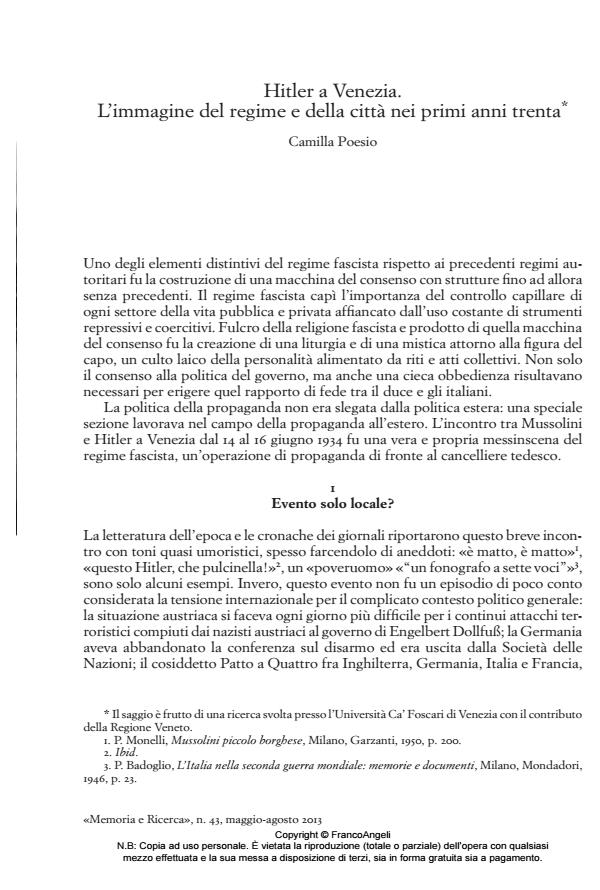Hitler a Venezia. L’immagine del regime e della città nei primi anni trenta
Titolo Rivista MEMORIA E RICERCA
Autori/Curatori Camilla Poesio
Anno di pubblicazione 2013 Fascicolo 2013/43
Lingua Italiano Numero pagine 22 P. 145-166 Dimensione file 4502 KB
DOI 10.3280/MER2013-043010
Il DOI è il codice a barre della proprietà intellettuale: per saperne di più
clicca qui
Qui sotto puoi vedere in anteprima la prima pagina di questo articolo.
Se questo articolo ti interessa, lo puoi acquistare (e scaricare in formato pdf) seguendo le facili indicazioni per acquistare il download credit. Acquista Download Credits per scaricare questo Articolo in formato PDF

FrancoAngeli è membro della Publishers International Linking Association, Inc (PILA)associazione indipendente e non profit per facilitare (attraverso i servizi tecnologici implementati da CrossRef.org) l’accesso degli studiosi ai contenuti digitali nelle pubblicazioni professionali e scientifiche
This article focuses on Hitler’s visit in Venice from 14 to 16 June 1934. Mussolini and Hitler met each other for the first time. Unlike Mussolini, Hitler wanted to meet the Italian Politician since long time. Why the Fascist regime accepted to meet the new chancellor? Why it took place in Venice? Was the visit really insignificant like has been seen for a long time? This article argues that the Fascist regime used Hitler’s visit for propaganda goals and chose Venice for symbolic and political reasons. The event had a deep impact. Especially Hitler was impressed with Mussolini who showed himself in different ways, like leader of Fascist party, leader of Fascist militia, club-man of the high venetian society, brain of venetian modernisation, devoted catholic, "father" of venetian orphans. The meeting didn’t produce significant political developments, but had a transnational impact: three years after, the first Mussolini’s visit in Germany was organised on the model of Hitler’s one.
Parole chiave:Venice, Benito Mussolini, Adolf Hitler, Propaganda, Foreign relations, Transnational History
- Rewriting German History Christian Goeschel, pp.247 (ISBN:978-1-349-57150-5)
- STAGING FRIENDSHIP: MUSSOLINI AND HITLER IN GERMANY IN 1937 CHRISTIAN GOESCHEL, in The Historical Journal /2017 pp.149
DOI: 10.1017/S0018246X15000540
Camilla Poesio, Hitler a Venezia. L’immagine del regime e della città nei primi anni trenta in "MEMORIA E RICERCA " 43/2013, pp 145-166, DOI: 10.3280/MER2013-043010